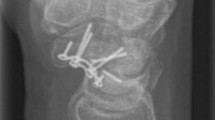Abstract
Background
The literature describes the treatment of scaphoid fractures comparing the volar and dorsal approaches, the advantages and disadvantages of percutaneous screw fixation, as well as the treatment of scaphoid nonunions using different types of cancellous or corticocancellous bone grafts. Yet, to date no studies are available comparing the outcome of rotational stability in screw-fixed scaphoid fractures to angular stable systems. The purpose of this study is to provide reliable data about rotational stability in stabilised scaphoid fractures and to gain information about the rigidity and the stability of the different types of fixation.
Methods
Three groups of different stabilisation methods on standardised scaphoid B2 fractures were tested for rotational stability. Stabilisation was achieved using one or two cannulated compression screws (CCS) or angular stable plating. We performed ten repetitive cycles up to 10°, 20° and 30° rotation, measuring the maximum torque and the average dissipated work at angle level.
Results
Our study showed that rotational stability using a two CCS fixation is significantly (p < 0.05) higher than single CCS fixation. Using the angular stable plate system was also superior to the single CCS (p < 0.05). There was, however, no significant difference between two CCS fixation and angular stable plate fixation.
Conclusion
Even though indications of using screws or plate systems might be different and plate osteosynthesis may be preferable in treatment of dislocated or comminuted fractures as well as for nonunions, our study showed a better rotational stability by choosing more than just one screw for osteosynthesis. Angular stable plating of scaphoid fractures also provides more rotational stability than single CCS fixation. The authors therefore hypothesise higher union rates in scaphoid fractures using more stable fixation systems.






Similar content being viewed by others
References
Menapace KA, Larabee L, Arnoczky SP et al (2001) Anatomic placement of the Herbert-Whipple screw in scaphoid fractures: a cadaver study. J Hand Surg Am 26:883–892
Haisman JM, Rohde RS, Weiland AJ (2006) American Academy of Orthopaedic Surgeons. Acute fractures of the scaphoid. J Bone Joint Surg Am 88:2750–2758
Hackney LA, Dodds SD (2011) Assessment of scaphoid fracture healing. Curr Rev Musculoskelet Med 4:16–22
Roolker W, Maas M, Broekhuizen AH (1999) Diagnosis and treatment of scaphoid fractures, can non-union be prevented? Arch Orthop Trauma Surg 119:428–431
Meermans G, Verstreken F (2012) Influence of screw design, sex, and approach in scaphoid fracture fixation. Clin Orthop Relat Res 470:1673–1681
Steinmann SP, Adams JE (2006) Scaphoid fractures and nonunions: diagnosis and treatment. J Orthop Sci 11:424–431
Buijze GA, Ochtman L, Ring D (2012) Management of scaphoid nonunion. J Hand Surg Am 37:1095–1100
Rhemrev SJ, Ootes D, Beeres FJ et al (2011) Current methods of diagnosis and treatment of scaphoid fractures. Int J Emerg Med 4:4
Luria S, Hoch S, Liebergall M et al (2010) Optimal fixation of acute scaphoid fractures: finite element analysis. J Hand Surg Am 35:1246–1250
Ram AN, Chung KC (2009) Evidence-based management of acute non-displaced scaphoid waist fractures. J Hand Surg Am 34:735–738
Merrell GA, Wolfe SW, Slade JF 3rd (2002) Treatment of scaphoid nonunions: quantitative meta-analysis of the literature. J Hand Surg Am 27:685–691
Neshkova IS, Jakubietz RG, Kuk D, Jakubietz MG, Meffert RH, Schmidt K (2015) Percutaneous screw fixation of non- or minimally displaced scaphoid fractures. Oper Orthop Traumatol 27(5):448–454
Ghoneim A (2011) The unstable nonunited scaphoid waist fracture: results of treatment by open reduction, anterior wedge grafting, and internal fixation by volar buttress plate. J Hand Surg Am 36:17–24
Toby EB, Butler TE, McCormack TJ et al (1997) A comparison of fixation screws for the scaphoid during application of cyclical bending loads. J Bone Joint Surg Am 79:1190–1197
Hannemann PF, Brouwers L, Dullaert K, van der Linden ES, Poeze M, Brink PR (2015) Determining scaphoid waist fracture union by conventional radiographic examination: an analysis of reliability and validity. Arch Orthop Trauma Surg 135(2):291–296
Roh YH, Noh JH, Lee BK, Baek JR, Oh JH, Gong HS, Baek GH (2014) Reliability and validity of carpal alignment measurements in evaluating deformities of scaphoid fractures. Arch Orthop Trauma Surg 134(6):887–893
McCallister WV, Knight J, Kaliappan R et al (2003) Central placement of the screw in simulated fractures of the scaphoid waist: a biomechanical study. J Bone Joint Surg Am 85:72–77
Dodds SD, Panjabi MM, Slade JF 3rd (2006) Screw fixation of scaphoid fractures: a biomechanical assessment of screw length and screw augmentation. J Hand Surg Am 31:405–413
Soubeyrand M, Biau D, Mansour C et al (2009) Comparison of percutaneous dorsal versus volar fixation of scaphoid waist fractures using a computer model in cadavers. J Hand Surg Am 34:1838–1844
Hart A, Mansuri A, Harvey EJ et al (2013) Central versus eccentric internal fixation of acute scaphoid fractures. J Hand Surg Am 38:66–71
Leixnering M, Pezzei C, Weninger P et al (2011) First experiences with a new adjustable plate for osteosynthesis of scaphoid nonunions. J Trauma 71:933–938
Dodds SD, Halim A (2016) Scaphoid plate fixation and volar carpal artery vascularized bone graft for recalcitrant scaphoid nonunions. J Hand Surg Am. doi:10.1016/j.jhsa.2016.04.021
Acknowledgments
We thank Adrian Spiegel for his support. Without his input and help we could not have managed to finish our study.
Author information
Authors and Affiliations
Corresponding author
Ethics declarations
Conflict of interest
Josef Jurkowitsch, M.D. received an International Bone Research Association (IBRA) Research Grant for carrying out this biomechanical study. All other authors, their immediate families, and any research foundations with which they are affiliated have not received any financial payments or other benefits from any commercial entity related to the subject of this article.
Rights and permissions
About this article
Cite this article
Jurkowitsch, J., Dall’Ara, E., Quadlbauer, S. et al. Rotational stability in screw-fixed scaphoid fractures compared to plate-fixed scaphoid fractures. Arch Orthop Trauma Surg 136, 1623–1628 (2016). https://doi.org/10.1007/s00402-016-2556-z
Received:
Published:
Issue Date:
DOI: https://doi.org/10.1007/s00402-016-2556-z




